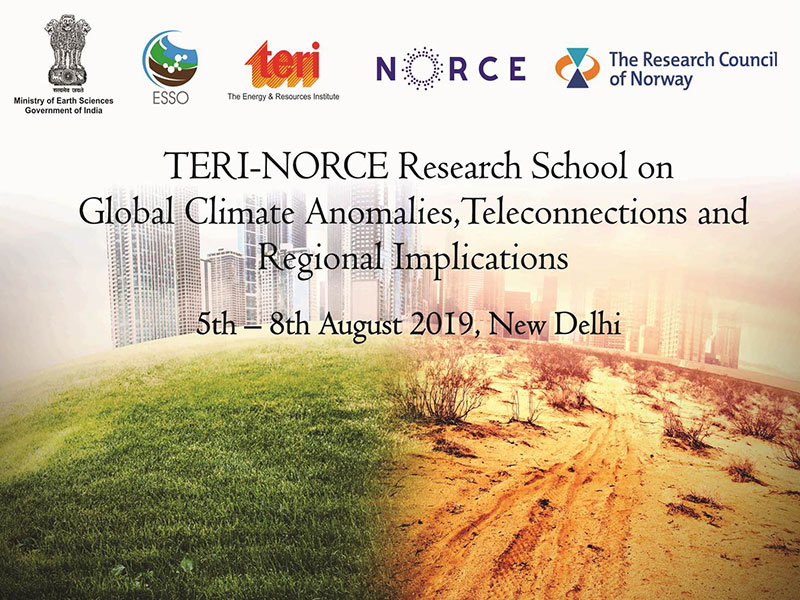C-ICE: Counteracting effect of future Antarctic sea-ice loss on projected increases of summer Monsoon rainfall
Introduction
South-Asian society and economy are heavily dependent on seasonal rainfall during the Indian Summer Monsoon (ISM). This rainfall has large spatio-temporal variability, the main pattern of which is expressed in an alternation of "break" and "active" phases. Break phases imply dry conditions over India’s main agricultural areas. When sufficiently prolonged or repeated in the course of the season, they are associated with droughts. Food production is highly sensitive to both dry and wet rainfall extremes. Under anthropogenic climate change, model-derived projections generally predict an increase in seasonal-mean rainfall totals along with a reduction in the number of rainy days. However, the associated spatio-temporal patterns of change in mean rainfall are very uncertain.
The transition between break and active phases of the ISM corresponds with a large meridional excursion of the precipitation maximum, reflecting a tendency for rainfall to occur over preferred geographical loci: one over the Gulf of Bengal and the Indo-Gangetic plains; and one over the Equatorial Indian Ocean. These map onto oscillations of the zonal-mean Inter-Tropical Convergence Zone, suggesting a link with the global circulation. As a result, the position and intensity of the ITCZ are sensitive to changes in extratropical heat sources. The antarctic sea-ice loss will result in an additional heat source in the SH of about 0.3 PW in austral winter.
Hence, we will investigate whether a substantial ISM rainfall response may be induced by large-scale interhemispheric heating anomalies. The focus will be on future Antarctic sea-ice loss, the associated heat-flux changes, and their impact on the global atmospheric circulation.
Objective
The overall objective of C-ICE project is to understand the potential impact of Antarctic sea-ice loss on the Indian Summer Monsoon (ISM). The focus will be given to the atmospheric large-scale circulation dynamics involved in the teleconnection linking remote changes in the extra-tropics to the tropical monsoon dynamics.
About C-ICE Project
A future Antarctic sea-ice loss may lead to a substantial and robust impact on the spatio-temporal distribution of ISM rainfall. We expect that the Antarctic future sea-ice loss is more important for the ISM than that projected for the Arctic because the heating anomalies associated with the sea-ice reduction are by far the largest in the corresponding winter season. The hypothesis is two-fold and rests on two distinct parts
- The first part concerns the atmospheric energy budget, whereby Antarctic sea-ice loss reduces the southern-hemisphere winter atmospheric heat deficit in such a way that less energy has to be transported by the Hadley circulation from the warmer summer Northern Hemisphere (NH). The adjustment of the solstitial Hadley cell leads to a southward shift of the mean ITCZ.
- The second part concerns the link between the mean ITCZ and the spatial distribution of ISM rainfall, whereby a southward shift of the ITCZ may favour break-type circulation regimes for the ISM.
These considerations suggest that Antarctic sea-ice loss could partially counteract global-warming influences on the ISM and may have an effect on its variability. The plausibility of the two parts of our argument has received strong support from a growing body of literature. The novelty of our investigation consists not only in suggesting this link, but also in elucidating the dynamical mechanisms involved in each of the two parts, their robustness, and their potential relevance for the future climate.
Scientific questions addressed in C-ICE and our hypotheses
- How do changes in Antarctic sea-ice cover affect the mid-latitude storm activity in the Southern Hemisphere in terms of heat and momentum transport?
- Hypothesis: sea-ice changes are effective in changing the integrated properties of the storm-track in terms of poleward heat and momentum exports through changes in storm frequency, intensity or life cycles
- How do the Hadley circulation and the Intertropical Convergence Zone (ITCZ) adjust in response to changes in southern mid-latitude heat and momentum transport during boreal summer?
- Hypothesis: a reduction in mid-latitude poleward heat transport induces a reduction in cross-equatorial heat transport, resulting in a seasonal southward shift of the ITCZ
- Would a southward shift of the ITCZ in boreal summer manifest itself in a changed distribution of Indian Summer Monsoon rainfall?
- Hypothesis: a southward shift of the ITCZ negatively impacts ISM rainfall, e.g. by favouring break-like changes in the regional circulation
Project Team
- Dr. Thomas Toniazzo, NORCE, Bergen, Norway
- Mr. Saurabh Bhardwaj, The Energy and Resources Institute (TERI), New Delhi, India
- Mr K. Venkatramana (TERI)
- Mr Santosh Kumar Muriki (TERI)
- Dr. Juergen Bader, Max Planck Institute for Meteorology, Hamburg, Germany
- Dr. Kevin Hodges, University of Reading, UK
- Dr. Tom Bracegirdle, British Antarctic Survey, Cambridge, UK
Events

TERI in collaboration with the NORCE, Norway as a part of bilateral Indo-Norwegian collaboration between MOES, GoI and Research Council Norway titled "Counteracting effect of future Antarctic sea-ice loss on projected increases of summer Monsoon rainfall (C-ICE)" organized a four-day residential research school from August 5-8, 2019.
Collaborator
Support
The project is a part of a bilateral Indo-Norwegian collaboration between Indian Ministry of Earth Sciences (MoES) and Research Council Norway (RCN).
Publications
- Shreya T., Nehru M., et al.,(2018), Monsoon Active/Break analysis over Indian region: An assessment using CMIP5 climate models Background and Objectives, TROPMET 2018, National Symposium on Understanding Weather and Climate Variability,October, 2018,Varanasi, India.





